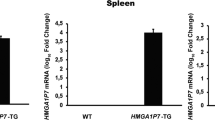Abstract
INFECTION of mice with Moloney murine leukaemia virus (MuLV) induces T-cell lymphomas after an average latency period of 150 days. In these lymphomas the MuLV DNA is frequently integrated into the mouse chromosomal DNA in the vicinity of the pim-1 oncogene1. Transgenic mice overexpressing the pim-1 oncogene are predisposed to develop T-cell lymphomas, but only to the extent that ∼10% of the mice develop a lymphoma within 240 days. When these mice are infected with MuLV, lymphomas develop in all mice in only 50—60 days2. In these lymphomas MuLV DNA is integrated near either the c-myc or N-myc gene, suggesting that pim-1 and myc synergize in lymphomagenesis1,2. To determine whether this system has a more general application, we have now tested the susceptibility of pim-1 transgenic mice to N-ethyl-N-nitrosourea (ENU), a chemical carcinogen. With a single low dose of ENU, nearly all pim-1 transgenic mice, but only 15% of non-transgenic mice, develop T-cell lymphomas within 200 days. All ENU-induced lymphomas in both pim-1 transgenic and non-transgenic mice express high levels of c-myc messenger RNA, supporting the notion that pim-1 and c-myc synergize in lymphoma induction2. We propose that pim-1 transgenic mice could be used to test the oncogenic potential of other chemical compounds.
Similar content being viewed by others
References
Cuypers, H. T. et al. Cell 37, 141–150 (1984).
Van Lohuizen, M. et al. Cell 56, 673–682 (1989).
Frei, J. & Lawley, P. J. natn. Cancer Inst 64, 845–856 (1980).
Warren, W. et al. Carcinogenesis 8, 163–172 (1987).
Van Lohuizen, M., Breuer, M. & Berns, A. EMBO J. 8, 133–136 (1989).
Barbacid, M. A. Rev. Biochem. 56, 779–827 (1987).
Diamond, L. E., Guerrero, I. & Pellicer, A. Molec. cell. Biol. 8, 2233–2236 (1988).
Bargmann, C., Hung, M. & Weinberg, R. Cell 45, 649–657 (1986).
Quintanilla, M., Brown, K., Ramsden, M. & Baimain, A. Nature 322, 78–80 (1986).
Hogan, B. L. M., Constantini, F. & Lacy, E. Manipulation of the Mouse Embryo: a Laboratory Manual (Cold Spring Harbor Laboratory, New York, 1986).
Selten, G., Cuypers, H. T., Zijlstra, M., Melief, C. & Berns, A. EMBO J. 3, 3215–3222 (1984).
Selten, G. et al. Cell 46, 603–611 (1986).
Berns, A. J. M. et al. J. Virol. 36, 254–263 (1980).
Dodemont, H. J. et al. EMBO J. 1, 167–171 (1982).
Saiki, R., Bugawan, T., Horn, G., Mullis, K. & Erlich, H. Nature 324, 163–166 (1986).
Bos, J. L. et al. Nature 327, 293–207 (1987).
Verlaan-de Vries, M. et al. Gene 50, 313–320 (1986).
Author information
Authors and Affiliations
Rights and permissions
About this article
Cite this article
Breuer, M., Slebos, R., Verbeek, S. et al. Very high frequency of lymphoma induction by a chemical carcinogen in pim-1 transgenic mice. Nature 340, 61–63 (1989). https://doi.org/10.1038/340061a0
Received:
Accepted:
Issue Date:
DOI: https://doi.org/10.1038/340061a0
- Springer Nature Limited
This article is cited by
-
Reduced expression but not deficiency of GFI1 causes a fatal myeloproliferative disease in mice
Leukemia (2019)
-
The role of PIM1/PIM2 kinases in tumors of the male reproductive system
Scientific Reports (2016)
-
MYC in pancreatic cancer: novel mechanistic insights and their translation into therapeutic strategies
Oncogene (2016)
-
Loss of PIM2 enhances the anti-proliferative effect of the pan-PIM kinase inhibitor AZD1208 in non-Hodgkin lymphomas
Molecular Cancer (2015)
-
PI3K-like kinases restrain Pim gene expression in endothelial cells
Journal of Huazhong University of Science and Technology [Medical Sciences] (2012)





